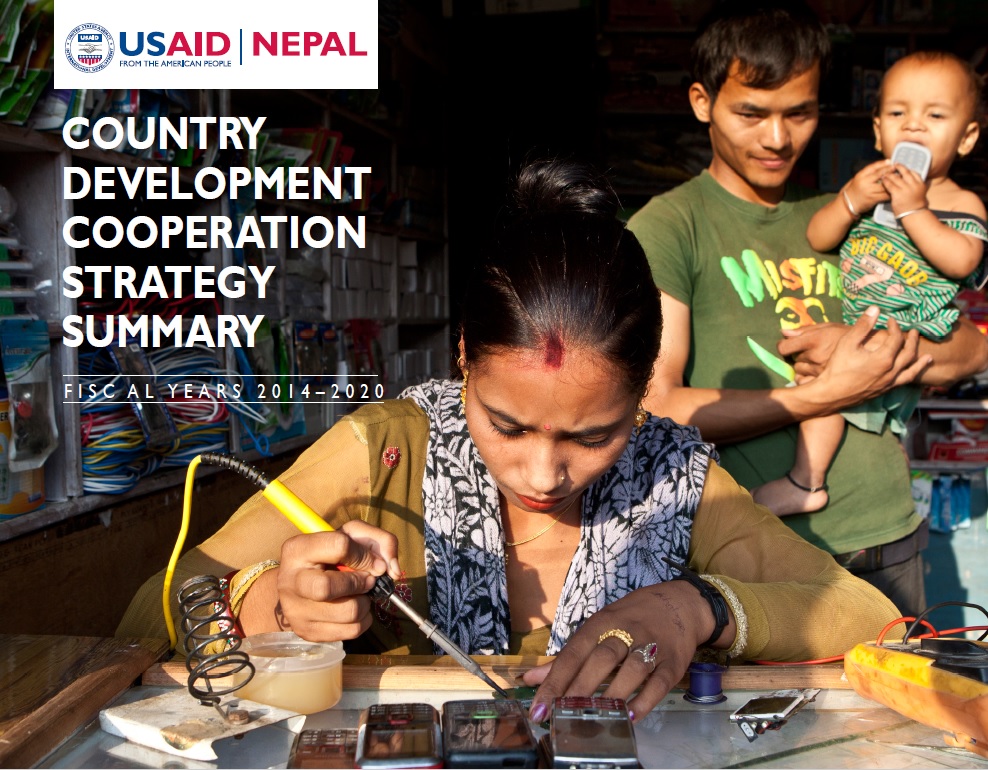Speeches Shim
On January 23, 1951, the United States and Nepal signed the first bilateral donor agreement that launched an almost 70-year relationship.
Country Development Cooperation Strategy 2014-2020 ![]() (pdf - 13 MB)
(pdf - 13 MB)
Over this period, the U.S. has provided more than $1.6 billion in assistance that has supported remarkable progress. Since the 2006 Comprehensive Peace Agreement ended a decade of conflict, the poverty rate has been halved to 25 percent, access to education is dramatically improved, and the country is on the way to achieving Millennium Development Goals for maternal and infant mortality rates. The 2013 national elections - which USAID was proud to support - were credible and inclusive, with over 75 percent voter participation.
Together with the Government of Nepal (GON), USAID is focusing on supporting Nepal’s democracy and the economic growth needed to eliminate extreme poverty, build resilience, and lift the country out of its ‘Least Developed’ status.
Development Hypothesis
The overarching goal of USAID’s five-year Country Development Cooperation Strategy (CDCS) is to foster “a more democratic, prosperous, and resilient Nepal.” The Mission asserts that if selected institutions become more effective at delivering services, more adept at engaging citizens—and more responsive to their needs— and if communities’ economic, environmental and human capacity are strengthened, then Nepal will become more democratic, prosperous, and resilient.
Strategic Choices
Approximately 75 percent of USAID Nepal’s funding resources are tied to U.S. Presidential Initiatives for Global Health, Feed the Future, and Global Climate Change, with additional funds earmarked for basic education and biodiversity. In developing this CDCS, the Mission conducted extensive consultations with the GON, private sector, civil society, U.S. Government stakeholders, and others, and identified good governance as critical to achieving success in each of these sectors. Support to governance will result in sustainable impact through multisector efforts that build increasingly strong relationships with the GON. USAID Nepal contends that U.S. foreign assistance is better secured through stronger Nepali institutions and their ability to implement sector programs.
USAID will also focus efforts geographically to leverage its programs and relationships across sectors for better collaboration, especially locally. The expected results include greater transparency, government credibility, and public confidence in the targeted sectors. Except as required by the need to assist certain ecosystems, vulnerable populations, specific disease burdens, or coverage needs (especially for nutrition and HIV/AIDS), USAID activities will be increasingly co-locate within 20 core districts in the middle hills and Terai portions of Nepal’s Far-Western, Mid-Western, and Western Development Regions. This area has a higher level of poverty than the national average (32.5 percent vs. 25.2 percent nationwide) and a higher level of stunting (45.2 percent vs. 40.5 percent nationwide). The region is also typified by high population density, less developed infrastructure, and vulnerability to climate change, yet possesses significant unmet agricultural, economic, and nature conservation potential.
Taking into consideration resource levels and USAID’s historic comparative advantage, the CDCS features four Development Objectives (DOs) to contribute to achieving the CDCS goal:
- Development Objective 1: More inclusive and effective governance
- Development Objective 2: Inclusive and sustainable economic growth to reduce extreme poverty
- Development Objective 3: Increased human capital
- Development Objective 4: Post-earthquake Nepal rebuilt to be disaster resilient and well positioned for sustainable development
Results Framework
These four DOs are mutually reinforcing. Democracy depends on political rights and civil liberties supported by stable and accountable institutions. Economic growth requires a healthy and educated population to take advantage of opportunities in an ever more sophisticated global economic environment. And democratic systems require an educated and empowered population. Because the DOs are so interconnected and because the Mission’s approach will emphasize the integration of crosssector development and governance to achieve sustainable results, development activities designed under this strategy may support results under multiple DOs. For example, USAID’s Global Health Initiative (DO 3) may contribute expertise, planning, and funding to support clean water under (DO 2) natural resource management activities.
CDCS Timeline
Original Dates: April 9, 2014 - April 8, 2019
Extended through: September 30, 2020
First Amendment: February 13, 2015
Second Amendment: December 5, 2016
Updated: November 30, 2018
Additional Resources
USAID/Nepal CDCS 2014-2018 Annex 1: Transition Objective (PDF)
Extended through: December 31, 2020



Comment
Make a general inquiry or suggest an improvement.